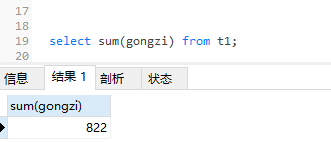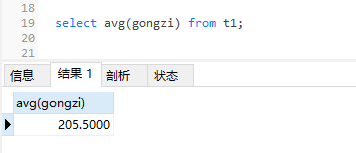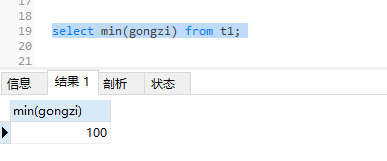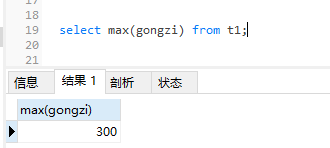1. Writing order
-select
-from
-join
-on
-where
-group by
-having
-order by
-limit
2. Execution sequence
- from
- where
- join
- on
- select
- group by
- having
- distinct
- order by
- limit
- union / union on
3.Hive relational operator [common]
| != | Not equal to |
| <> | Not equal to |
| == | Wait for |
| = | be equal to |
| + | plus |
| - | reduce |
| * | ride |
| / | except |
| >= | Greater than or equal to |
| <= | Less than or equal to |
4. Mathematical function [common]
4.1 rounding function: round
select round(11.214563);
Return to 11
--Rounded to the nearest whole number
2. Specify precision rounding function: round
round(double a, int b)
Example:
select round(11.256,2); -- 11.26
4.2 rounding down function: floor
SELECT floor(10.954) ;
Return 10
four point three Round up ceil/ ceiling
select ceil(12.006); / select ceiling(12.006);
Return 13
4.4 random number function: rand
grammar: rand(),rand(int seed)
Return value: double
explain:Return a double Random number in the range of type 0 to 1. If you specify a seed seed,Will wait until a stable sequence of random numbers
select rand();
return: 0.7400880291262728
-- The specified seed returns the same result
select rand(50);
0.7297136425657874
select rand(50);
0.7297136425657874
4.5 power operation function: pow
grammar: pow(double a, double p), power(double a, double p)
Return value: double
explain:return a of p Power
select pow(2,5);
Return 32.0
four point six Square function: sqrt
grammar: sqrt(double x)
Return value: double
explain:return x Square root of
select sqrt(4);
Return 2.0
four point seven Binary function: bin
grammar: bin(BIGINT x)
Return value: string
explain:return x Binary string for
select bin(4);
Return 100
4.8 absolute value function: abs
grammar: abs(double x),abs(int x)
Return value: double OR int
explain:Return value x Absolute value of
select abs(-2.0);
Return 2
4.9 judging positive and negative functions: sign
grammar: sign(double a)
Return value: double
explain:If a A positive number returns 1.0,Returns a negative number-1.0,Otherwise, 0 is returned.0
select sign(10);
Return 1.0
select sign(-10.0);
return -1.0
select sign(0);
Return 0.0
four point one zero Inverse function
grammar: negative(int x), negative(double x)
Return value: int or double
explain:return-x or x Opposite number of
select negative(-5);
Return 5
select negative(5);
return -5
4.11 mathematical function: pi
grammar: pi()
Return value: double
explain:Mathematical constantπ
select pi();
Return 3.141592653589793
4.12 function for finding the maximum number of N: greatest
grammar:greatest(T v1, T v2, ...) N Maximum number of
Return value:T
explain:Find the maximum value
select greatest(1,2,3);
Return 3
4.13 function for finding the minimum number of N: least
grammar:least(T v1, T v2, ...)
Return value:T
explain:Find the minimum value
select least(1,2,3);
Return 1
4.14 banker rounding function: broad
grammar:bround(double a)
Return value:double
explain:Banker's rounding method
select bround(5.5)
Return 6
select bround(4.5)
Return 4
5, Date function
five point one UNIX timestamp to date function: from_unixtime
grammar: from_unixtime(bigint unixtime, [string format])
Return value: string
explain: format The format can be“ yyyy-MM-dd hh:mm:ss","yyyy-MM-dd hh","yyyy-MM-dd hh:mm"etc.
select from_unixtime(1634000000,'yyyy-MM-dd');
Back to 2021-10-12
select from_unixtime(1634000000,'yyyy-MM-dd HH:mm:ss')
Back to 2021-10-12 00:53:20
five point two Get current UNIX timestamp function: unix_timestamp
grammar: unix_timestamp()
Return value: bigint
explain:Gets the current time zone UNIX time stamp
select unix_timestamp();
Return to 1633679199
SELECT from_unixtime(unix_timestamp(),'yyyy-MM-dd HH:mm:dd');
Back to 2021-10-08 15:48:10
five point three Date to UNIX timestamp function: unix_timestamp
grammar: unix_timestamp(string date)
Return value: bigint
explain:The format can only be'yyyy-MM-dd HH:mm:ss'Converts the time string of to a timestamp. Returns 0 if the conversion fails.
SELECT unix_timestamp('2021-10-08 15:50:00');
Return to 1633708200
SELECT unix_timestamp('2021-10-08');
Return 0
five point four Specify date format to UNIX timestamp function: unix_timestamp
grammar: unix_timestamp(string date, string pattern)
Return value: bigint
explain:Converts the specified time string format string to Unix Timestamp. Returns 0 if conversion fails
select unix_timestamp('2021-10-08','yyyy-MM-dd');
Return to 1633651200
five point five Date time to date function: to_date
grammar: to_date(string timestamp)
Return value: string
explain:Returns the date portion of the date time field
select to_date('2021-10-08 15:00:00');
Back to 2021-10-08
five point six Date to year function: year
grammar: year(string date)
Return value: int
explain:Returns the year in the date time field
select year('2021-10-08 15:00:00');
select year('2021-10-08');
Back to 2021
five point seven Date to month function: month
grammar: month(string date)
Return value: int
explain:Returns the month in the date time field
select month('2021-10-08 15:00:00');
select month('2021-10-08');
Return 10
five point eight Date conversion function: day
grammar: day(string date)
Return value: int
explain:Returns the date in the date time field
select day('2021-10-08 15:00:00');
select day('2021-10-08');
Return 8
five point nine Date to hour function: hour
grammar: hour(string date)
Return value: int
explain:Returns the date in the date time field,Note that if the format is wrong, 0 is returned
select hour('2021-10-08 15:00:00');
Return to 15
select hour('2021-10-08');
Return 0
5.10 date to minute function: minute
10. Date to minute function: minute
grammar: minute (string date)
Return value: int
explain:Returns the minute in the date.
select minute('2021-10-08 15:10:00');
Return 10
5.11 date to second function: Second
grammar: second (string date)
Return value: int
explain:Returns the second in the date.
select second('2011-12-08 10:03:01');
Return 1
5.12 date to week function: weekofyear
grammar: weekofyear (string date)
Return value: int
explain:The return time string is the week ordinal of the year
select weekofyear('2021-10-08 15:00:00');
Return 40
5.13 date comparison function: datediff
grammar: datediff(string enddate, string startdate)
Return value: int
explain:Returns the number of days from the end date minus the start date.
select datediff('2021-10-08','2021-10-01');
Return 7
5.14 date addition function: date_add
grammar: date_add(string startdate, int days)
Return value: string
explain:Return start date startdate increase days Date in days.
select date_add(2021-10-01,7);
Back to 2021-10-08
5.15 date reduction function: date_sub
grammar: date_sub(string startdate, int days)
Return value: string
explain: Return start date startdate reduce days Date in days.
select date_sub('2021-10-08',8);
Back to 2021-10-01
5.16 current time date function: current_date
grammar:current_date()
Return value:date
explain:Returns the current time and date
select current_date();
Back to 2021-10-08
5.17 current time date function: current_timestamp
grammar:current_timestamp()
Return value:timestamp
explain:Returns the current timestamp
select current_timestamp();
select last_day(current_timestamp());
Back to 2021-10-08 12:25:22.339
Function added in May 18: add_months
grammar:add_months(string start_date, int num_months)
Return value:string
explain:Return to current time and add num_months Date of month
select add_months('2021-10-08',2);
2021-12-08
5.19 date function of last day: last_day
grammar:last_day(string date)
Return value:string
explain:Returns the date of the last day of the month, ignoring the hours, minutes and seconds( HH:mm:ss)
select last_day(current_date());
select last_day(current_timestamp()); -- Ignore the hours, minutes and seconds section( HH:mm:ss)
Back to 2021-10-31
5.20 date function corresponding to next week X: next_day
grammar:next_day(string start_date, string day_of_week)
Return value:string
explain:Returns the next week of the current time X The corresponding date is as follows: next_day('2015-01-14', 'TU')
= 2015-01-20 To 2015-01-14 Is the start time, and the corresponding date of the next Tuesday is 2015-01-20
select next_day(current_date(),'su');
2021-10-10
5.21 specified format return time function: date_format
grammar:date_format(date/timestamp/string ts, string fmt)
Return value:string
explain:Returns the time in the specified format date For example: date_format("2016-06-22","MM-dd")=06-22
select date_format(current_date(),'MM-dd');
Return 10-08
5.22 current week function: dayofweek
grammar:dayofweek(date)
Return value:int
explain:Day of the week on the return date
select dayofweek(current_date());
Return 6
6, Conditional function
6.1 If function: if
grammar: if(boolean testCondition, T valueTrue, T valueFalseOrNull)
Return value: T
explain: When condition testCondition by TRUE When, return valueTrue;
Otherwise return valueFalseOrNull(valueTrue,valueFalseOrNull (is generic)
Similar to ternary expression
select if(10>5,1,0);
Return 1
select if(10<5,1,0);
Return 0
6.2 empty lookup function: nvl
grammar: nvl(T value, T default_value)
Return value: T
explain:If value Value is NULL Just return default_value,Otherwise return value
select nvl(null,1);
Return 1
select nvl(2,1);
Return 2
be careful: select nvl('',1); return ''
6.3 non null lookup function: COALESCE
grammar: COALESCE(T v1, T v2,...)
Return value: T
explain: Returns the first non null value in the parameter; if all values are NULL,Then return NULL
select coalesce(1,2,null,...);
Return 1
select coalesce(null,null,2,...);
Return 2
select coalesce(null,null,null,...);
return null
6.4 condition judgment function: CASE
grammar: CASE a WHEN b THEN c [WHEN d THEN e]* [ELSE f] END
Return value: T
Note: if a be equal to b,Then return c;If a be equal to d,Then return e;Otherwise return f
select CASE 4 WHEN 5 THEN 5 WHEN 4 THEN 4 ELSE 3 END;
Return 4
6.5 condition judgment function: CASE
grammar: CASE WHEN a THEN b [WHEN c THEN d]* [ELSE e] END
Return value: T
Note: if a by TRUE,Then return b;If c by TRUE,Then return d;Otherwise return e
select
case
when a > 10 and a < 20 then '10-19 year'
when a >= 20 and a < 30 then '20-30 year'
else '30 Over years old'
end as 'age group'
6.6 null value judgment function: isnull
grammar: isnull( a )
Return value:boolean
Note: if a by null Just return true,Otherwise return false
select isnull(5);
return false
select isnull(null);
return true
select * from ads_class
where classid is null;
Returns results that meet the criteria
6.7 non null value judgment function: isnotnull
grammar: isnotnull ( a )
Return value:boolean
Note: if a For non null Just return true,Otherwise return false
select isnotnull(5);
return true
select * from ads_class
where classid is not null;
Returns results that meet the criteria
7, Aggregate function [generally used with grouping function or windowing function]
Do not count null values
seven point one Number statistics function: count
grammar:count(*), count(expr), count(DISTINCT expr[, expr...])
Return value: BIGINT
explain: count(*)Count the number of retrieved rows, including NULL Rows of values;
count(expr)Returns the number of non null values of the specified field;
count(DISTINCTexpr[, expr_.])Statistics provide non NULL And after weight removal expr Number of rows of expression value
select count(1) from tb_class;
Usually used with grouping functions

seven point two sum statistics function: sum
2. Summation statistical function: sum
grammar: sum(col), sum(DISTINCT col)
Return value: double
explain: sum(col)Statistical result set col The result of the addition of; sum(DISTINCT col)In the statistical results col Result of adding different values
select sum(money) from order

seven point three Average statistical function: avg
grammar: avg(col), avg(DISTINCT col)
Return value: double
explain: avg(col)Statistical result set col Average value of; avg(DISTINCT col)In the statistical results col Average of different values added

seven point four Minimum statistical function: min
grammar: min(col)
Return value: double
explain:Statistical result set col Minimum value of the field

seven point five Maximum statistical function: max
grammar: maxcol)
Return value: double
explain:Statistical result set col Maximum value of the field

8, Grouping function
| class | name | age | event_day | gongzi |
|---|
| 1 | Zhang San | 15 | 2021-05-01 | 100 |
| 2 | Li Si | 14 | 2021-05-03 | 200 |
| 3 | Wang Wu | 13 | 2021-05-05 | 100 |
| 1 | Zhao Liu | 15 | 2021-04-30 | 200 |
| 2 | Zhang San | 17 | 2021-06-01 | 300 |
group by According to by The data is grouped according to which field, or which fields.
grammar: group by Followed by grouping fields,Multiple fields can be separated by commas
select field from Table name where condition group by field
perhaps
select field from Table name group by field having Filter condition
Note: for filter conditions, you can use where,Reuse group by Or use it first group by,Reuse having
group by Cannot appear after where function,because where Pre production line
8.1 examples:
Group individual fields
select class, count(1) as cnt
from tb_class
group by class -- be careful select Fields that do not participate in grouping cannot appear after grouping
Grouping multiple fields[Number of people with the same name in each class]
select class,name,count(1) as cnt
from tb_class
group by class,name
8.2 often used with aggregate functions count() , sum() , avg() , max() , min()
1. count() --Number of students in each class
select class,count(1) as cnt from tb_class group by class;
be careful: If count(distinct field) Low efficiency,If there is a large amount of data,Not recommended
[Because use count(distinct)Syntax aggregation reduce Will become a to complete the aggregation]
have access to group by plus count To replace completion
2.sum() -- Total salary of each class
select class,sum(gongzi) as total_gongzi from tb_class group by class;
3.avg() --Average age per class
select class, avg(age) from tb_class group by class;
4.max() --Maximum age per class
select class, max(age) from tb_class group by class;
5.min() --Minimum age per class
select class, min(age) from tb_class group by class;




